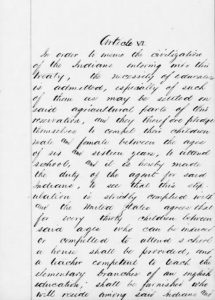When finding a text to research and write about in this post, the Tentative Course of Study for United States Indian Schools immediately caught my attention. This text, drafted by the Office of Indian Affairs, states that the Course of Study provided in the text is to be adopted by schools of the Indian school service.1 Children were required to attend these schools as a part of a treaty deal between a tribe and the United States government; both male and female children between the ages of six and sixteen were to endure the process of cultural assimilation and be instructed in the English language.2

Article VI; Treaty with the Navajo Tribe at Fort Sumner3
Within the text, an entire section is dedicated to the importance of, “training the senses,” and develop[ing] all the powers and functions of the human mind.”4 Music is named as the only subject that can synchronize the senses in a way that is “enjoyable to the individual and helpful to the community,” but this is quickly followed by a list of particular criteria that must be followed in the classroom when music is being taught.5 Unsurprisingly, these specifications uphold a legacy of cultural superiority. For example, in order to help students develop a sense of musical appreciation, they are only allowed to hear music deemed as good, which according to the text, seems to be limited to American patriotic songs and classical music composed by well-known European composers, such as Mozart, Haydn, and Beethoven.6 Additionally, the text presents individual aspects of music that can be used to further assimilate students into Western culture, like preferring a “good, smooth, sweet, light, pure tone,” over “raggedness” and “huskiness.”7
These schools masqueraded as institutions that concerned themselves with the education and futures of Native American children. However, when considering how these schools use subjects like music to perpetuate cultural supremacy, the deeply problematic intention of these school to assimilate Native American children becomes blatantly obvious.
1 Tentative course of study for United States Indian Schools. Govt. Print. Off., 1915. https://www.aihc.amdigital.co.uk/Documents/Images/Ayer_386_U5_1915/61?searchId=8c6fcef2-55e4-4583-b1cf-9be3f19eeaff
